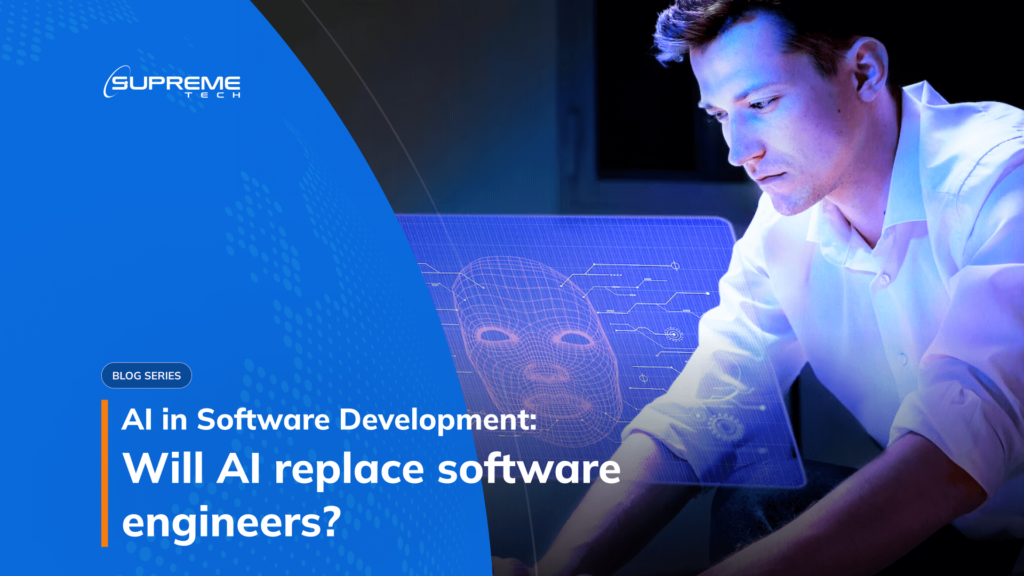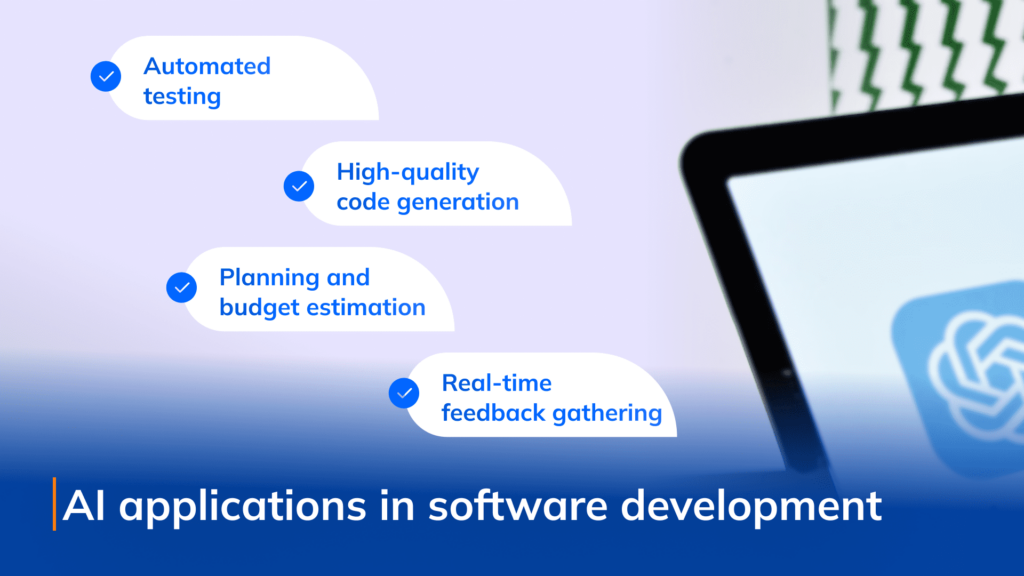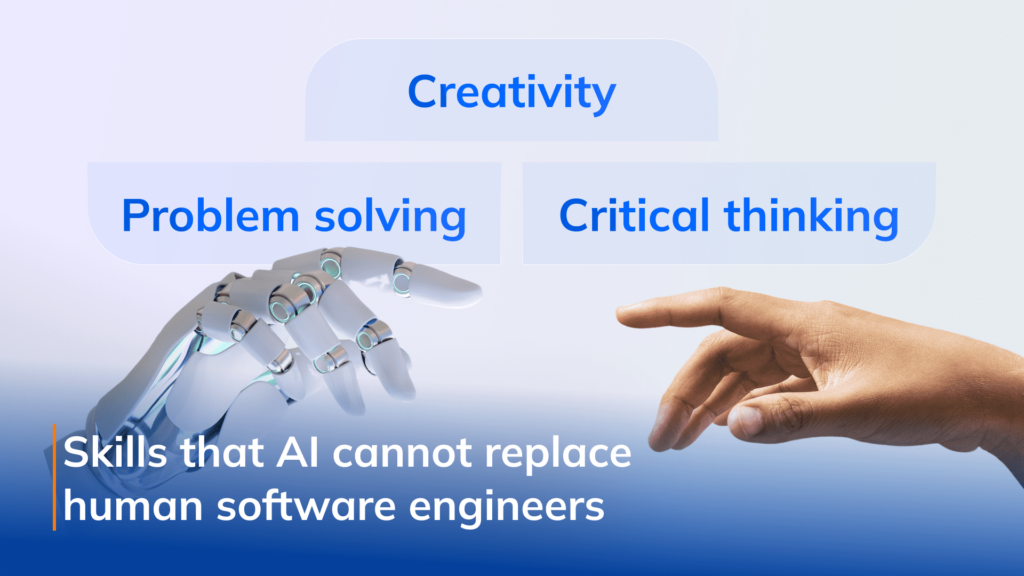AI in Software Development: Will AI replace software engineers?
27/07/2023
1.11k
Table of Contents
The AI revolution is sweeping the IT and tech industries, transforming how we approach software development. As businesses strive to stay competitive in this rapidly evolving landscape, the role of AI in software development cannot be ignored. The question that arises is whether AI will eventually replace software engineers. In this blog post, SupremeTech will delve into the world of AI in software development and explore the relationship between AI and skilled software engineers.
See more:

The Impact of AI on Software Development
Transformation of Traditional Software Development Practices
AI has ushered in a paradigm shift in traditional software development practices. By leveraging machine learning algorithms and advanced data analytics, AI has the potential to revolutionize how software is designed, developed, and deployed. It brings automation, optimization, and efficiency to various software development life cycle stages, reshaping how software is created and maintained.
Examples of AI Applications in Software Development
Generative AI applications in software development span various areas, each contributing to the overall improvement of the process. One notable example is automated testing, where AI algorithms can analyze vast amounts of code and test scenarios, identify potential bugs, and provide recommendations for improvement. This significantly speeds up the testing process, enhances test coverage, and improves the overall quality of the software.
Another example is AI-powered code generation, where machine learning models can generate code snippets based on specific requirements and patterns. This helps developers accelerate their coding process, reduces the likelihood of errors, and improves the overall efficiency of software development.
Additionally, AI is increasingly used for intelligent debugging, where algorithms can analyze error logs, identify patterns, and suggest potential fixes. This assists software engineers in quickly diagnosing and resolving complex issues, ultimately saving time and effort.
Learn more: AI Hiring Tools and Next-Gen Recruiting Platforms
Benefits of Using AI in Software Development
The integration of AI in software development brings forth a plethora of benefits. Firstly, it significantly increases productivity by automating repetitive and time-consuming tasks. This allows software engineers to focus their efforts on more complex and creative aspects of development, leading to faster project delivery and increased innovation.

Moreover, AI reduces the time and cost involved in software development. By automating tasks such as testing, code generation, and debugging, AI streamlines the development process and minimizes the need for manual intervention. This results in shorter development cycles, reduced resource requirements, and ultimately lower business costs.
Furthermore, AI enhances software accuracy and quality. Machine learning algorithms can analyze vast amounts of data, identify patterns, and make intelligent predictions. This helps identify potential risks, improve code quality, and enhance the overall robustness and reliability of software products.
By harnessing the power of AI in software development, businesses can unlock significant advantages, gaining a competitive edge in the market while delivering high-quality software more efficiently and cost-effectively. The statistics speak for themselves, with studies showing that companies leveraging AI in their software development processes experience higher productivity, faster time to market, and improved customer satisfaction.
Embracing AI in software development is no longer a choice but a necessity for businesses seeking to stay ahead in today’s rapidly evolving technological landscape. The benefits of increased productivity, reduced time and cost, and improved accuracy drive the widespread adoption of AI in the industry, setting the stage for a new era of software development.
The Role of Software Engineers in the AI Era
Skills and Expertise Software Engineers Bring to the Table
Software engineers possess unique skills and expertise that make them invaluable in the AI era. They are highly trained professionals with in-depth knowledge of programming languages, algorithms, software design principles, and problem-solving techniques. Their ability to translate complex business requirements into functional software solutions is paramount in delivering successful projects.
Moreover, software engineers deeply understand the software development life cycle and possess domain-specific knowledge. They are adept at collaborating with stakeholders, understanding user needs, and ensuring the software meets the desired specifications. These skills make software engineers indispensable in the development process, as they provide the human element necessary to bridge the gap between technology and business.
How AI Complements and Enhances the Work of Software Engineers
Rather than replacing software engineers, AI complements and enhances their work in numerous ways. AI serves as a powerful tool that can assist software engineers in automating repetitive tasks, optimizing performance, and improving overall efficiency. By leveraging AI algorithms, software engineers can gain valuable insights, accelerate development cycles, and make informed decisions.
For instance, AI can analyze large volumes of data and extract meaningful patterns, enabling software engineers to make data-driven decisions in their software development processes. Additionally, AI-powered tools can assist in code review, detecting potential vulnerabilities and suggesting improvements. These tools augment the expertise of software engineers, ensuring that the code is robust and secure.
Furthermore, AI can be employed in the maintenance phase of software development, monitoring system performance, detecting anomalies, and providing proactive recommendations for improvement. This empowers software engineers to focus on higher-level tasks and strategic decision-making, rather than spending time on routine maintenance activities.
The Future of AI and Software Engineering

While AI holds immense potential, challenges and ethical considerations need to be addressed. One of the challenges is ensuring transparency and accountability in AI systems. As AI algorithms become more complex, understanding their decision-making process and addressing issues such as bias and fairness become crucial.
Data privacy and security concerns arise due to reliance on large datasets for AI models. Software engineers must navigate these challenges responsibly, implementing safeguards and ethical practices to ensure the responsible use of AI in software development.
AI Will Augment, Not Replace, the Role of Software Engineers
In the face of technological advancements, it is important to reiterate the key message that AI will augment, not replace, the role of software engineers. AI is a tool that empowers software engineers, enhancing their capabilities and streamlining their work. Skilled software engineers bring unique expertise, creativity, critical thinking, and problem-solving skills indispensable in developing innovative software solutions. The future of software engineering lies in harnessing the potential of AI while embracing the collaboration between AI and human intelligence. Together, they can drive the evolution of software engineering, leading to breakthroughs and advancements in the field.
Discover how SupremeTech applies AI
We use AI to develop the features of our own products. AI is considered the top priority in our R&D activities. Explore how we built an AI-powered CV-reviewing feature for Talenten.
Contact us to see how AI can enhance your business performance too!
Related Blog





















